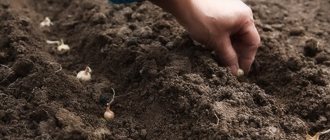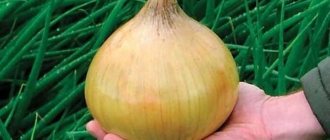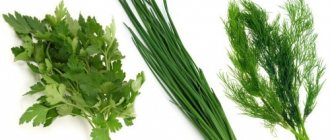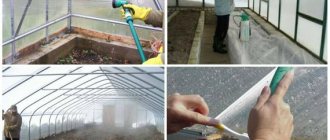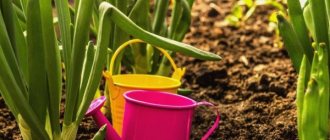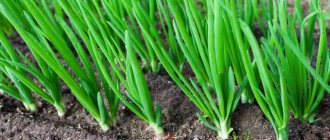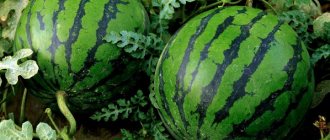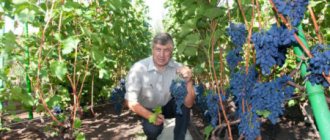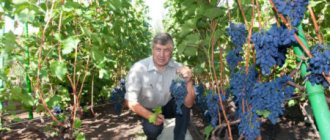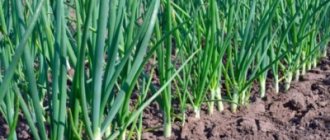Let's talk about a very interesting culture. Growing onions - leeks, onions, for feathers - is quite a popular activity among lovers of country holidays. We suggest you understand the nuances of planting and caring for this crop. The fact is that, having started cultivating it for the first time, not everyone achieves good harvests, but all because you need to know some secrets, which we want to tell you about. Don't have your own site? No problem! Make a mini garden and plant onions on the windowsill! Growing it is a common thing for many apartment owners.
Leek seeds
Growing onions from seeds is a simple process. You need to start with proper preparation. Their germination persists for three years. So, let's start by treating the seeds (this is disinfection). To do this, before planting, they need to be placed in water: first in hot water (45 degrees), and then in cold water.
If you want to get quick shoots, it is better to germinate the seeds. To do this, lay them out on a wet cloth and leave them in a warm place. In a couple of days it will be possible to dry them a little and then sow them. This needs to be done at the end of February.
Treatment must be carried out if you are going to sow your own seeds. Purchased ones, and especially imported ones, as a rule, are already disinfected.
Diseases and pests
If you give the plant the necessary care, you can avoid damage from various pests and diseases. If planting starts, leeks can be damaged by various parasites.
- viral mosaic can infect the plant after the picking process. Yellow spots appear on the green part, and the development of the onion itself stops. To avoid possible infection, use only fresh seeds as planting material;
Viral mosaic is a contagious disease. If it is detected, severely affected plants must be removed
- the onion fly is the worst enemy that can eat away the leaves of the crop, and the larvae of this parasite infect the white part of the plant, after which it can be thrown away. In order to prevent onion flies, leeks are planted next to carrots.
Leeks: growing seedlings
In the southern regions, it is quite possible to grow onions by sowing them directly into the ground in the second half of May. And in the central and northern regions of Russia, the crop is planted in the form of seedlings. This is due to the growing season of the plant.
To get good seedlings, the following sowing dates are recommended:
- In February, plant the seeds in boxes on the window.
- In mid-April - in a glazed greenhouse or under film in the garden bed.
Leeks require a day length of 10-12 hours. Therefore, if you sow seeds in February, the seedlings will need additional lighting.
Let's start growing onions in winter by sowing the seeds in small boxes with moist soil. Furrows should be made at a distance of five centimeters. Planting depth is 1.5-2 cm. The pots are covered with film and placed in a warm, well-lit place (+ 25 degrees). As soon as the first shoots appear, the film is immediately removed. The temperature in the room should be gradually reduced to fifteen degrees during the day and to ten at night. At this temperature, the crops are kept for seven days. Then the schedule is gradually changed. During the day the temperature should be no more than twenty degrees, and at night - 10-14 degrees. This regime is then maintained throughout the entire period of growing seedlings.
Compliance with the temperature schedule is a very important condition for the future harvest. Temperatures that are too warm for seedlings will result in early flower shoots, which should appear in the second year rather than the first. As you can see, you have to work hard to get the leeks. Growing seedlings is a troublesome business.
Exactly after a month, the dense shoots can be thinned out so that the distance between them is a couple of centimeters. Seedlings dive into pots, the diameter of which can be up to four centimeters.
So we sowed onions. The methods of growing it may be different. Good seedlings are obtained by using peat pots and tablets, because in this case there is no need to pick the plants.
Seedlings can be watered with compost tea. Growing onions should be accompanied by regular fertilizing. Preferably every two weeks during the entire growing period.
What else should you pay attention to when taking up an activity such as growing onions at home? We advise you to trim its leaves so that their length does not exceed 9-10 centimeters. This should be done every couple of weeks, which will promote better root growth and thickening of the stems.
Before planting onions in open ground, seedlings need to be hardened off. To do this, the pots are taken outside, the plants will gradually get used not to home conditions, but to fresh air.
It should be noted that seedlings grow rather slowly. 6-8 weeks after planting, seedlings can be planted in the ground if the stem has reached 5-8 millimeters in diameter.
Harvesting and storage
Leeks are harvested based on the time frame in which they are expected to be consumed. If you do it right away, you can pluck feathers throughout the entire growth period. For long-term storage, the plant is picked in the fall. It is important not to damage the above-ground part during assembly.
You can store the harvest in the freezer by cutting the onion into rings and placing them in a bag in a 5-centimeter layer. The plant is actively used for preparing spices. In this case, you will need well-dried and finely chopped feathers. The best specimens can be stored entirely in perforated bags in the refrigerator.
How to plant seedlings correctly?
Growing onions will give good yields on light, fertile loamy soils with a neutral environment.
In the fall, when preparing the area for planting, you can add fertilizer or compost. And in the spring, the beds can be sprinkled with humus. It’s good if potatoes, tomatoes, cucumbers, cabbage or legumes grew on this land in front of the onions. Seedlings are planted in open ground in May.
Before planting, it is recommended to slightly trim the leaves and roots (the roots can be soaked in a mash of mullein and clay). This way the plants will take root better.
For planting, you need to prepare the holes. Their depth should be no more than twelve centimeters. Compost or manure must be placed at the bottom. One plant is planted in each hole. Next, the roots are sprinkled with earth, watered and finally dug in.
The technology for growing onions and planting is as follows:
- Two-row - the distance between seedlings is approximately fifteen or twenty centimeters with a row spacing of thirty centimeters.
- Multi-row - the distance between plants is ten to fifteen centimeters, with row spacing up to thirty centimeters.
Onions are best grown in narrow rows. If you have large distances between the rows, then you can sow carrots. These plants go together wonderfully. Onions are also friends with strawberries, celery and beets. These plants can be planted in onions. The cultivation and care of these crops can be combined as they are friendly to each other. This means that they will not interfere with one another.
Selecting a variety and preparing seeds for planting
When going for leek seeds, it is important to choose the right variety for growing
The name here is of secondary importance; the main thing you need to pay attention to is the timing of crop maturation. All varieties of leeks can be divided into early, middle and late
Early ripening leek is also called summer leek. Plants complete stem formation 130-150 days after sprouts appear. They are dug up in August; they have an average yield and are not stored for a long time. Typically, such onions are used immediately for cooking or frozen for future use. It has a delicate, pleasant taste. Early ripening varieties can be grown without restrictions in any region. The most famous among gardeners include:
- Vesta;
- Goliath;
- Elephant's trunk;
- Columbus;
- Kilima.
Mid-season varieties need 150-180 days to ripen. They are characterized by a darker leaf color, a large stalk, often with a pronounced bulb, and high resistance to infectious diseases. This leek is harvested in the fall, in September or October, stored for several months, used fresh or canned. Mid-season varieties grow well in the south, middle zone and north. The following varieties have proven themselves well in garden beds:
- Tango;
- Jolite;
- Kamus;
- Bastion.
Late-ripening varieties are winter. They are intended for long-term storage, have a short, dense stem, and ripen 6 months after germination or more. They are distinguished by a large amount of vitamins and minerals, and tolerate low temperatures and even slight frosts. You can distinguish them in the beds by their dark-colored leaves with a waxy coating, which often have a spreading shape. The varieties most famous to gardeners include:
- Carentan leek;
- Mercury;
- Autumn Giant;
- Bandit;
- Elephant;
- Asgeos.
They are grown only in areas with long summers and harvested just before frost.
Pre-sowing preparation of leek seeds in the spring before planting is not always carried out. If you buy a bag in a store, its contents do not need additional processing. Such seeds are already treated with fungicides and have good germination. They can be sown dry, especially in open ground. They may sprout a few days later, but they won’t die if it gets cold outside.
For growing in a greenhouse and at home, seeds can be soaked in growth stimulants before planting. Own seed is first disinfected in a solution of potassium permanganate. To make seedlings appear faster, leek seeds are left in a damp cloth until germination. Next, they are dried a little and embedded in the ground.
How to care for onions?
Growing onions at home requires careful care of the crop. This includes loosening the soil, weeding, hilling, watering and fertilizing. Experts advise using mulching; this will make your work easier and create comfortable conditions for growing onions.
When the plant stems reach the diameter of a ballpoint pen, soil should be poured into the holes. Then every couple of weeks you will need to hill up the beds. This is necessary in order to get a longer white stem. In general, at least four such procedures need to be carried out per season. It is better to do this before watering.
It should be noted that onions are a demanding crop. He loves good soil and watering, which should be regular and plentiful. Feeding must also be present. Mullein and bird droppings are considered good fertilizers for onions. They are used in the form of solutions.
The most valuable part of the leek is the white stem, also called the stem. If you care for it correctly, the stem can reach fifty centimeters in length and up to four centimeters in width.
Leeks are a fairly cold-resistant crop. It can withstand frosts up to seven degrees. In regions with a mild climate, plants can easily overwinter under the snow while in open ground. Rainy and cool summers can lead to the formation of thin and short stems.
Description of culture
Leeks are a plant native to Asia whose growing season is 2 years. Belongs to the Onion subfamily of the Onion genus. Derived from wild grape onions. The visible part of the stem reaches a height of 100 cm or more. Distributed everywhere. Can be eaten at any stage of development. Of particular culinary interest is the bleached stem, which is the false stem.
This root vegetable was actively used for gastronomic purposes back in ancient states. In Europe, it began to be cultivated in the Middle Ages. It gained particular popularity in France, where it was called the poor man's asparagus.
Characteristics of the 24-month life cycle:
- First 12 months. Formation of rhizomes, foliage, false bulb and stem.
- Second year. Development of a peduncle with pink or white flowers. Thanks to cross-pollination, seeds are formed in the umbrella-shaped inflorescence.
Despite belonging to the onion subfamily, the bulb is poorly developed.
Leeks are used in almost all dishes, from salads to soups and main courses.
Varieties of leek
The classification is based on the timing of plant maturation. All known species are divided into 3 groups:
- Early. Harvest time is the last days of August and the beginning of September. The growing season is from 18 to 21 weeks. The most productive varieties.
- Mid-season. They ripen by October. Formed from 21 to 25 weeks. In terms of yield, they are inferior to the previous ones, but outshine in taste.
- Late. They mature in about 26 weeks. Suitable for consumption in early spring. In terms of yield, they are close to mid-season varieties.
Due to the fact that leek tolerates cold winters well, its cultivation is possible throughout the Russian Federation.
Among all varieties, the most productive varieties are early ripening ones.
Table 1. The most popular varieties
| Name | Characteristic | Leg parameters (diameter, mm/length, cm/weight, g) |
| Columbus (Early) | An excellent yielding leek native to the Netherlands. | 6/20/400 |
| Vesta (Early) | It is characterized by high productivity and sweet taste. The height of the crop reaches 1.5 m. | 5/30/350 |
| Elephant trunk (Early) | A distinctive feature is a long shelf life. However, to achieve a long bleached part, it is necessary to constantly hill up the plant. | 7/30/400 |
| Kilima (Early) | It has good yield and excellent taste. | 4/25/150 |
| Jolant (Mid-season) | Resistant to pathologies of fungal etiology. | 5/35/ 300 |
| Tango (mid-season) | Frost-resistant crop. | 5/12/250 |
| Bastion (Mid-season) | A variety that is not susceptible to the appearance of spots on the leaves. | 6/30/220 |
| Elephant (Late) | A weather-resistant crop of Czech selection with a pungent taste. | 10/25/200 |
| Autumn Giant (Late) | A Dutch variety characterized by excellent keeping quality. | 8/40/200 |
| Mercury (Late) | Practically resistant to viral diseases. | 7/25/200 |
The largest supplier of pearl onions is France
Prices for leek seeds
leek seeds
Medicinal properties of leek
Among onions, shallots and batun, it is considered the most delicious and nutritious.
Useful qualities:
- Contains a large amount of carotene, vitamins B1, B2, C and E, protein elements.
- Stops the development of malignant tumors.
- Helps in the treatment and prevention of arthritis, gout, asthma, scurvy, diarrhea, rheumatism, anthrax, obesity, insomnia, metabolic disorders, staphylococcal infections, vitamin deficiency, tuberculosis and urolithiasis.
- Improves liver functioning.
- Increases appetite.
- Increases hemoglobin levels.
- Accelerates wound healing.
Leeks have minimal caloric content, which allows them to be considered a dietary product.
Pearl onions are often used in creamy soups
Contraindications for use:
- In its unprocessed form, the culture is not recommended for diseases of the duodenum and stomach. This does not apply to heat-treated products.
- It is undesirable to use leek for pathologies of the bladder and kidney stones.
Overeating the plant leads to headaches.
100 g of onion contains 35 calories
Growing onions in greenhouses
There are late types of onions that are cold-resistant. However, they are unable to complete their growth due to the long growing season. Such varieties are grown under film. They also practice growing onions in greenhouses in winter.
Plants grown in the ground can be transplanted into boxes and moved to a warm room so that they can continue to grow there. This needs to be done in the autumn, before the onset of frost.
You can organize winter growing of onions. As a business, this is a great idea. In cold weather, its cost increases significantly, and so does demand. In winter, you really want something summery and fresh. Moreover, onions are known for their beneficial properties and antiviral effect.
Varieties
All possible bred varieties are divided into 3 types:
- early – ripening period is 130-150 days (“Columbus”, “Goliath”, “Vesta”, “Kilima”);
Columbus
- mid-season - the growing season is 150-180 days (“Tango”, “Bastion”, “Kamus”, “Cazimir”);
- late - the ripening period lasts more than 6 months (“Elephant”, “Sizokryl”, “Mercury”, leek).
Each of the presented groups has its own advantages. Thus, early varieties give the highest yield, mid-season varieties have a rich taste, and late varieties are suitable for long-term storage.
Greenhouse technology
Growing onions in a greenhouse is not a very difficult matter. There shouldn't be any big difficulties. It is better to sow those varieties that are suitable for these purposes. If planting occurs before winter, you can cover the plants with film. But you can organize onion cultivation as a business in a greenhouse. The fact is that in greenhouse conditions the harvest can be obtained much earlier.
First you need to dig up the beds and apply fertilizer. Superphosphate and potassium chloride are suitable. It is advisable to plant or transplant before mid-October. After all, the plants still need time to take root.
Planting should be done at a distance of one and a half or two centimeters. As soon as cold weather sets in, the plants are covered with peat, manure or straw.
By the end of March or at the very beginning of April, all insulating materials must be removed and only the film left. Plants need to be watered and fertilized. Nitrogen fertilizing should be used twice during the spring.
In early May, greenery will appear.
Growing onions in a heated greenhouse occurs differently. The boxes are first filled with peat and soil from the garden. When they want to achieve increased productivity, the bulbs are heated for a day at a temperature of forty degrees. Next, the neck of the plant is cut off. Care will be exactly the same as in other cases. This is watering and fertilizing. You will receive your harvest in thirty days. But to do this you will have to maintain the desired temperature. In the daytime - up to twenty degrees, and at night - up to fifteen.
Features of outdoor care
To grow a high-quality crop, you need to regularly water and weed the beds, apply fertilizing, loosen the soil between the rows and protect from parasites and diseases. However, the most important procedure is hilling. This is what makes it possible to get a good bleached stem.
Hilling is considered the main care procedure
Table 2. Care procedures
| Event | Description |
| Loosening | Frequency - once every 14 days. When the stem gets stronger, you should gradually add soil removed during planting to the holes. |
| Hilling | During 1 growing season, 4 approaches are made, starting in mid-July. Before each procedure, ash is placed under the stems at the rate of 250 g per 1 m² of bed. |
| Watering | The first 3 days after planting the seeds, the bed is not watered. Then the frequency of watering is once every 5 days at the rate of 15 liters of water per m². |
| Top dressing | During 1 season, the crop is fertilized 4 times. 20 days after sowing, the soil is watered with a mixture of potassium salt, ammonium nitrate and water in a ratio of 15 g/20 g/10 l. This volume is designed for 5 m². |
Recommendations for winter growing
If you want to get tall and high-quality greens, you will need additional lighting up to twelve hours a day. You cannot purchase small bulbs for planting, this will affect the harvest.
If you still decide to grow onions specifically for profit, then you should remember that there are days when they are purchased especially quickly. For example, before the New Year, March 8, February 23, Easter. Therefore, it makes sense to adjust the cultivation of plants to this particular time.
Winter preservation methods
For storage, leeks can be placed in a container with sand and don’t forget about fertilizer. The safety guarantee in this case will be six months.
When wintering on the balcony, the plant must be covered and the temperature maintained from 0 to -8 degrees. It is better to put eight onions in the refrigerator in plastic bags. Place onions in the freezer, cut into rings or strips. But dried vegetables last longer.
Growing this crop is not an easy task.
It requires attention and patience on the part of gardeners. Soil moisture and nutrition are important for growth.
Regular feeding and prevention of onion and leek diseases will allow you to obtain a healthy product.
Growing leeks
Growing onions at home on a windowsill
The red summer passes very quickly, and now autumn is on the doorstep, followed by winter. It’s good that we prepared for their arrival in advance by drying and freezing the food. But in the cold, you really want something fresh and tasty, and at the same time healthy. Of course, in winter, supermarkets are full of greens and fruits, but their prices are high. Therefore, you can try growing onions at home on the window. While harvesting, you will have a lot of fun and feel proud of yourself. You can place the onion on the windowsill. Growing plants is also possible at home. But there are some nuances here.
The stores have a huge range of potted products and boxes for indoor plants. However, a wooden or clay pot is the best choice. If you can’t find these, you can also use plastic containers. It is better to cover the bottom with oilcloth, making small holes in it for water drainage.
Seeds are sown in flower pots at the end of February. It is better to soak them first. The pots are filled two-thirds with soil, then the seeds are placed, and the top is covered with a couple of centimeters of soil. Next, all this is covered with film or a plastic bag. Every few days the film needs to be removed, watered, and then closed again. As soon as the first loops appear, the bags are removed. And the pots are placed on the windowsill. If the temperature outside is above zero, sometimes it can be taken out onto the veranda or balcony. During this period, the plants are carefully watered and protected from direct sunlight.
However, natural lighting may not be enough, because it is no secret that in autumn and winter the daylight hours are very short and the seedlings will need additional lighting. Alternatively, this can be artificial lighting using fluorescent fluorescent lamps. Please note that it is best to place a home garden on south-facing windows.
And remember to respect the temperature regime. All plants are very capricious regarding temperature changes. If you want to ventilate the room, it is better to remove the boxes with crops from the draft. Or cover them with something.
If the air in the room where the onions are located is dry, then it is better to spray the plants. Water the seedlings only with settled water at room temperature when the top layer of soil has dried out. Excess moisture should go into the pan. To prevent it from stagnating there, it makes sense to fill it with sand or gravel.
Do not over-moisten the soil, as the roots of the plants may begin to rot, which will lead to the death of the onion.
Conditions for germination of seedlings
It is recommended to grow leek seedlings according to certain rules in order to plant them in a greenhouse or open ground as soon as possible. Here are just the ones that deserve special mention:
1. Light. Snails or containers should be placed on the windowsill. If spring turns out to be cloudy, then you should think about artificial lighting.
2. Temperature. When growing seedlings, air temperature does not matter much. The most important thing is that the soil does not cool below 18 degrees.
3. Soil moisture. Leeks are a moisture-loving crop, so seedlings should be regularly sprayed with a spray bottle.
If you do everything correctly, the first shoots will appear in about 10-20 days. Otherwise, the seedlings may even die.
Are leeks susceptible to diseases?
Unfortunately, onions are susceptible to diseases. Yes, and there are pests that attack plants. For example, onion fly, fusarium, black mold, rust, downy mildew. In general, you need an eye to eye. Just make sure to keep an eye on the plants.
- Mosaic. This is a viral infection of onions. And it is carried by the common aphid. A sign of this disease is the appearance of longitudinal yellow spots. Sick seedlings stop growing. This disease can only be combated by destroying all affected onions. There are no other options. As a preventive measure, you can only fight ticks and aphids. Experts also advise using seeds that have been stored for a couple of years. The fact is that during this time the virus practically dies.
- Powdery mildew (downy mildew) is white spots that quickly spread throughout plants. Onions affected by this disease are inedible. Sick plants need to be removed. It makes sense to treat the beds with phytosporin or copper oxychloride. It is believed that the best prevention of this disease is proper agricultural technology.
- Leaf rust. It manifests itself in the appearance of yellow pads on plants. These are fungal spores. The affected leaves begin to dry out and then turn black. Plants with this disease must be urgently pulled out of the garden and destroyed to prevent the fungi from spreading to healthy onions.
- Of the pests, the onion fly causes the greatest damage. It devours the greenery of the leaf and leaves large gaps. Even the larvae of these flies can harm onions. They greatly damage the underground part of it. To repel pests, it is recommended to sow carrots between rows. The fly doesn't like its smell. Experts recommend watering the onions in such cases with a special solution: a glass of layers is filled with ten liters of water. The resulting mixture is watered at the roots of the beds. But it is recommended to sprinkle the soil itself with carrot seeds (ground) or pepper at the rate of a teaspoon per square meter. You can also use wood ash. It cannot be said that all these measures provide a complete guarantee of the disappearance of pests, but they will help preserve part of the crop and prevent its complete destruction.
Care
The plant requires special attention at the beginning of the growing season. After planting in the ground, this process is noticeably simplified. All you have to do is adhere to the following recommendations:
- There should be no weeds on the ridge, so it is necessary to carry out weeding in a timely manner.
- The soil should always be moistened, but there is no need to create a swamp. The volume of watering must be increased in June, at the time of the formation of the green part of the crop, and in July, at the time of the formation of the bulb.
- To form a beautiful white leg, the leek buds throughout the season. After loosening, the soil is thoroughly mulched with mowed grass or straw.
- A few weeks after planting the seedlings, fertilizing is done. It is better to use mullein or chicken droppings as fertilizer. The fertilizer solution is poured between the rows; there is no need to pour the liquid onto the onion itself. If the soil is nutritious, you can limit yourself to an infusion of fermented grass.
When fertilizing, it is necessary to carefully monitor the nitrogen concentration in the mixture. An excess of this element can lead to rotting of the onion, even during storage.
Secrets of experienced gardeners
Onion agricultural technology is not particularly complicated. However, experienced specialists in this matter have their secrets. They advise paying great attention to plants at the initial stage, immediately after planting. In the future, care will not be so troublesome.
The main rule is to carefully monitor the weeds in your garden. They definitely need to be pulled out. Watering and removing unnecessary grass should be basic maintenance principles.
The soil should always be moist. It’s bad when it dries out, but waterlogging and overflow should not be allowed.
During the season, you should hill up the beds three to four times. This will give you a chance to get a long white leg. After each hilling, the earth is mulched, for example, with straw or dry manure, dry grass.
Leeks have one interesting feature. It does not stop growing even when it is dug up and put in the basement for winter storage. Therefore, it is recommended to feed it often. This can be done for the first time as soon as the plant reaches twenty centimeters and has five leaves.
It is permissible to use such a solution: add a liter of mullein to ten liters of water. The resulting mixture is watered between the rows. Plants cannot be treated with the solution. It can burn the greens. This fertilizer is suitable for poor soil. If you cultivated the soil well before planting, you can get by with watering from herbal infusions, for example, nettle.
Remember that leeks are never fertilized with fertilizers containing a large amount of nitrogen; this leads to plant rotting even when stored in basements.
The watering schedule is very important for plants. Onions need good watering during the period of intensive growth of the green part in June, as well as during the formation of the bulbous part in July. The soil should be moist, but not too wet or dry. Any deviation from the norm will lead to undesirable consequences.
Onions are harvested in late autumn. However, it is able to overwinter in open ground, of course, if the winter is not very cold. In general, onions are a cold-resistant plant. In the middle zone it can be covered with pine needles or straw, or peat. And in the spring it begins to grow quickly, although the rest of the plants are just beginning to be planted.
Varieties included in the State Register of the Russian Federation
To date, foreign and domestic breeders have developed more than 100 varieties and hybrids of leeks. Some of them are officially registered in the State Register of the Russian Federation, are well adapted and approved for gardening throughout the country. Varieties are usually divided into groups with different ripening periods:
| Group/ripening period (from germination to technical ripeness) | Varieties/hybrids |
| Early and mid-early / 120-135 days | "Vesta", "Jumper", "Lancelot", "Elephant Trunk" |
| Average / about 140-160 days | “Gulliver”, “Giraffe”, “Casimir”, “Columbus”, “Krypton F1”, “Summer Breeze”, “Mammoth”, “Matejko F1”, “Autumn Handsome”, “Piccolo F1”, “Winner”, “ Tango", "Forrest" |
| Mid-late and late / up to 180-200 days | “Alligator”, “Asgeos”, “Bandit”, “Good fellow”, “Kamus”, “Karantansky”, “Pluston F1”, “Porbella” “Premier”, “Shogun”, “Elephant MS” |
As can be seen from the table, the list of recommended varieties is not yet very large and it is dominated by mid- and late-ripening varieties. When choosing the variety you are interested in, it is important to understand that:
- early ones - characterized by weak frost resistance, have lighter leaves and a tall (more than 25 cm) false stem, are not suitable for long-term storage;
- medium - their stem is shorter (15-22 cm high), but thicker, especially in the lower part, has the highest taste;
- late ones grow slowly, produce a short stem (7-12 cm) and leaves, colored dark green, can be stored all winter in proper conditions.
When cultivating leeks in Belarus, it was noted that early-ripening varieties have 1.2-1.7 times higher yields than varieties with later ripening periods
Instead of an afterword
Leeks are often found in vegetable gardens and summer cottages. This culture was brought to Russia in the middle of the last century. The popularity of this plant is enormous. This is probably due primarily to its beneficial properties. Onions can be eaten fresh, salted, frozen, or pickled. Essentially, this is a universal product. Even the stem is valuable. It is eaten throughout the summer and autumn. The younger the shoot, the tastier and juicier it is. And young leaves are used for salads and soups. They contain a lot of potassium, which activates metabolic processes in the body.
If you decide to start growing this miracle plant at home, we hope that our article will be useful to you. In fact, the process itself is not very complicated, and the plant cannot be called capricious. Try it and see for yourself.
Botanical description and beneficial properties
The mature crop looks about the same as young corn. Depending on the variety, the height of the plant can be from 0.4 to 0.9 meters. The leaves are greenish-blue in color, quite long (from 0.4 to 0.6 meters), and have a fan-shaped arrangement. The flowers are usually very small, collected in small white or pink umbrella-shaped inflorescences. Only the basal part of the plant, which is popularly called the stem, is eaten. The culture is propagated by seeds, which retain their viability for up to 4 years.
Now about the beneficial properties of leeks. When growing crops, gardeners and greenhouse growers pay attention to the following positive qualities:
1. Stimulates the action of the gastrointestinal tract.
2. Has a mild laxative and diuretic effect.
3. Normalizes the outflow of bile, preventing bladder disease.
4. Strengthens the body's protective functions, increasing immunity.
5. Able to heal small scratches when applied to a wound.
6. Restores the body after grueling workouts in the gym.
7. Prevents the development of diseases of the cardiovascular system.
8. Accelerates hair growth (if you rub the paste into the scalp).
9. Eliminates unwanted pigments on the face.
10. Used in folk recipes against calluses.
And this is all - a small part of the beneficial properties that leeks can boast of. However, do not forget that sometimes the culture is contraindicated for use. Therefore, before you start consuming vegetables for treatment and prevention, it is recommended to consult with an experienced doctor.
Soil and climate requirements
Leeks do not have excessive needs, but grow better in soils:
- fertile,
- rich in humus
- sandy-clayey.
Leeks grow worse on too light, sandy soils. The soil pH should be neutral, preferably 6-7.5.
Choose the sunniest location for growing leeks. Before winter, plowing (digging) with a depth of 25-30 cm is carried out. The beds should be placed in open places, away from ponds and lowlands. Areas with a mild and humid climate are better suited for growing onions. A temperature of only 3-4 degrees Celsius is sufficient for seed germination, but for the plant to enter the growth phase, it is necessary to provide warm conditions with a minimum temperature of 15-20 degrees Celsius. Leeks can withstand frosts down to -15 °C.
In addition to its high light requirements, leeks require fairly high humidity because they are sensitive to lack of water, especially during the germination and seedling stages and during growth.
Before sowing the seeds, the soil is thoroughly cleaned of weed residues, dug up, and leveled.
Fertilizer
Leeks are medium-deep-rooted plants and have high nutritional requirements.
Organic fertilizer is most desirable for growing this onion, so it should be grown in the first or second year after applying manure and compost. The recommended dose is 30-40 tons per hectare (300-400 kg per hundred square meters).
Organic fertilizer, especially organic matter that is not fully composted, should not be applied more than a year before planting. It is better to plant leeks on the site as a second vegetable after adding organic matter. Onion vegetables grow well after early harvested cucumbers or potatoes.
The more time passes from using manure, the more in subsequent years it will be necessary to supplement this type of fertilizer with mineral compounds.
Mineral fertilizer is applied to the soil (use preparations with basic nutrients - NPK 3 weeks before planting). If necessary, foliar fertilizing is also used, usually with nitrogen fertilizers, no later than 6 weeks before harvest. Heavy rains require a 30% increase in doses.
Approximate doses of mineral fertilizers (active ingredient kg / per hundred square meters):
- nitrogen – 1-1.5;
- phosphorus – 0.6-1;
- potassium – 1-1.5.
Phosphorus and potassium fertilizers, as well as half the dose of nitrogen, are applied 2 weeks before planting the seedlings, the rest of the nitrogen is applied later.
Doses of phosphate fertilizers are determined based on chemical analysis. The optimal phosphorus content in the soil should be at least 60-80 mg/dm³. In the absence of fertilizer recommendations, the approximate dose is 1-1.5 kg/acre in the form of double superphosphate.
The potassium content in the soil should be at least 150 mg/dm³ on light soils and 300 mg/dm³ on medium soils. In the spring, potassium sulfate is added at a dose of 1-2 kg/acre.
When planting leeks, nitrogen fertilizers are usually applied twice:
- before sowing (planting seedlings);
- in the plant growth phase - usually 2 months after the first dose.
Foliar feeding is especially valuable in the 4-6 leaf phase.
Predecessors
Good predecessors for growing leeks are vegetables that leave the beds early. This onion is ideal to grow after the following crops:
- cucumbers;
- tomatoes;
- celery;
- cruciferous vegetables (early cabbage, cauliflower);
- carrot;
- pumpkin;
- cereals (except oats).
It is not recommended to grow leeks after bulbous plants due to the high risk of disease and pest infection. The break in growing onions in one place should be 3-4 years.
